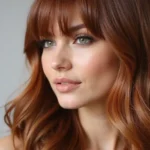We’ve all seen that effortlessly chic hairstyle taking over social media feeds and red carpets – the butterfly haircut. This trending look isn’t just another passing fad; it’s a sophisticated blend of vintage glamour and modern styling that’s capturing hearts worldwide.
The butterfly haircut cleverly combines the best elements of shag and layered cuts to create face-framing layers that move like butterfly wings. What makes this cut truly special is its incredible versatility – it works beautifully on various hair textures and face shapes while adding instant volume and movement.
Whether you’re looking to refresh your current style or make a bold transformation, we’re here to guide you through everything you need to know about this captivating cut. From understanding the technique to styling tips and maintenance secrets, we’ll help you decide if the butterfly haircut is your next perfect match.
What Is the Butterfly Haircut and Why It’s Trending
The butterfly haircut represents a contemporary evolution of classic layered cuts, featuring dramatic face-framing layers that create natural volume and movement. This versatile style has dominated social media feeds and celebrity red carpets throughout 2025 and 2025.
Origins of the Butterfly Haircut Style
Stylists first developed this technique by combining elements from the iconic shag and wolf cuts of the 1970s. Professional colorists and hairdressers noticed how traditional layered cuts could be reimagined to create more dramatic face-framing effects. The name comes from the way shorter layers around the face resemble butterfly wings when styled with volume and texture.
Celebrity stylists began popularizing this cut when A-list stars like Billie Eilish and Sabrina Carpenter showcased variations on red carpets. Social media platforms amplified the trend as influencers shared transformation videos showing the dramatic before-and-after effects. Hair professionals report that client requests for butterfly cuts increased by over 300% between 2022 and 2025.
Key Characteristics That Define This Cut
Graduated layers form the foundation of every butterfly haircut, with the shortest pieces typically falling around the cheekbones or jawline. These layers create natural volume without requiring extensive styling products or tools.
Face-framing sections distinguish this cut from traditional layered styles through their strategic placement around the temples and cheeks. Stylists cut these pieces at exact angles to enhance facial features and create movement when hair moves naturally.
Length variation allows for customization across different hair types and personal preferences. We see butterfly cuts adapted for shoulder-length hair, long styles that reach the collarbone, and even shorter variations that work with bob-length hair.
Textural elements give the cut its signature lived-in appearance through point cutting and razor techniques. These methods create softer edges compared to blunt cutting techniques used in more structured styles.
Versatile styling options make this cut suitable for both casual and formal occasions without requiring dramatic changes to the hair’s natural texture or extensive heat styling.
Face Shapes That Work Best With the Butterfly Haircut

Understanding your face shape helps determine if this versatile cut will enhance your natural features. Different facial structures benefit from exact styling approaches with butterfly layers.
Oval Face Shape Compatibility
Oval faces work exceptionally well with butterfly haircuts since this face shape naturally balances all hairstyle proportions. The graduated layers complement your face’s natural symmetry while adding texture and movement around the perimeter. We recommend emphasizing the shorter face framing pieces to highlight your cheekbones and jawline.
Styling flexibility becomes your biggest advantage with an oval face shape. You can wear the butterfly cut with center parts, side parts, or even pulled back into loose updos. The layered structure maintains its shape regardless of how you choose to wear it daily.
Round Face Shape Considerations
Round faces benefit from butterfly haircuts when styled to create vertical lines and elongate facial features. The key lies in keeping volume at the crown while allowing the face framing layers to sit closer to your cheeks. Avoid adding excessive width at the sides which can emphasize roundness.
Strategic layering placement makes all the difference for round face shapes. We suggest asking your stylist to concentrate shorter layers around the cheekbone area rather than at jaw level. This technique draws attention upward and creates the illusion of length.
Side parts work better than center parts for round faces with butterfly cuts. The asymmetrical styling naturally breaks up facial roundness while the longer layers add vertical emphasis to your overall silhouette.
Square and Angular Face Shape Benefits
Square and angular face shapes gain important softening effects from butterfly haircuts due to the wispy, graduated layers. The textured ends work to minimize sharp jawlines while creating gentle movement around harsh facial angles. Face framing pieces should start around chin length to balance strong jaw structures.
Layered volume at the crown helps elongate square faces while the butterfly’s signature soft layers counteract angular features. We find that tousled styling techniques work particularly well since they enhance the cut’s natural texture and movement.
Avoiding blunt lines becomes crucial for angular face shapes with butterfly cuts. The graduated layering naturally creates softer edges that complement rather than compete with your facial structure’s natural geometry.
Essential Techniques for Cutting the Perfect Butterfly Haircut
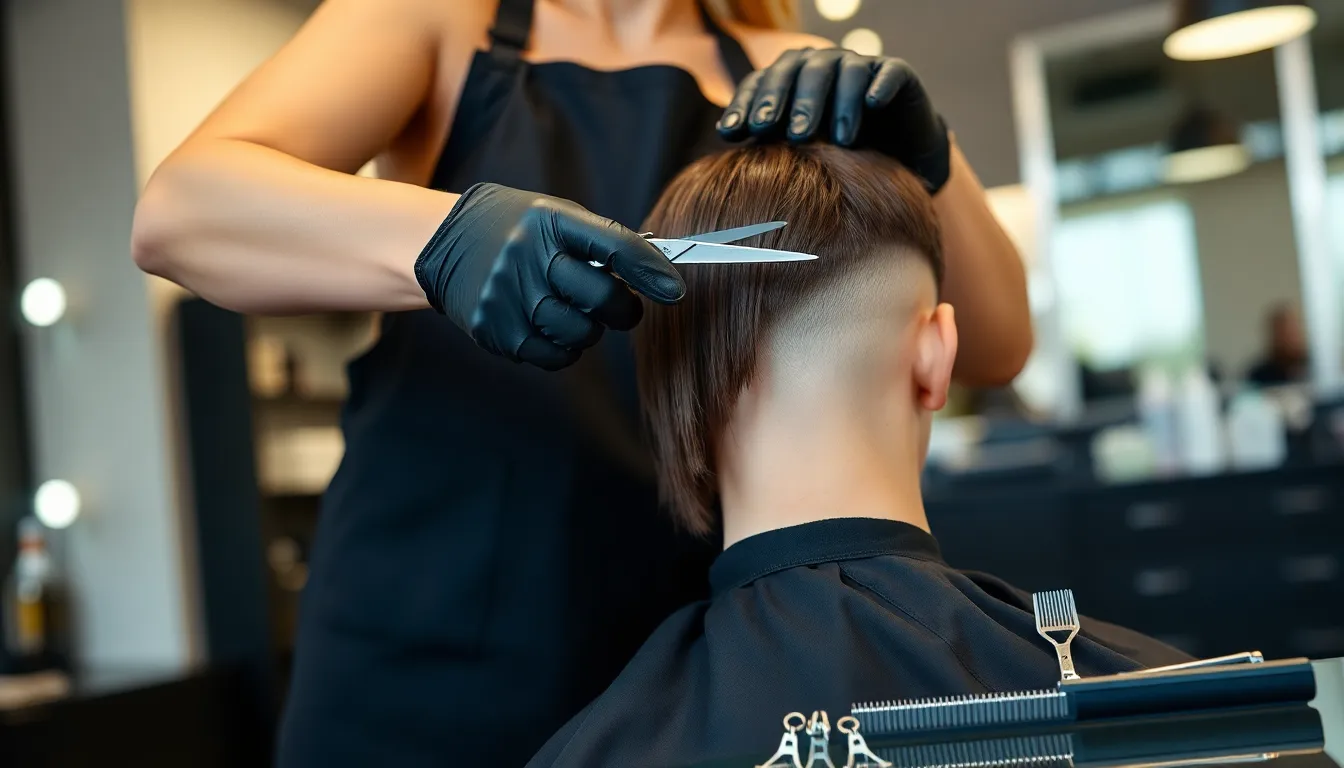
Mastering the butterfly haircut requires exact cutting techniques that create those signature face-framing layers while maintaining the hair’s natural movement. We’ll break down the professional methods that transform ordinary hair into this stunning, voluminous style.
Layering Methods for Maximum Volume
Point cutting creates the foundation for butterfly haircut layers by removing bulk while maintaining texture. We use vertical cuts into the hair shaft at a 45-degree angle, which softens edges and allows layers to blend seamlessly. This technique prevents the choppy appearance that can occur with blunt cuts.
Slide cutting adds movement and reduces weight throughout the mid-lengths and ends. We position the shears parallel to the hair shaft and slide them down while opening and closing the blades. This method creates natural-looking graduation that mimics the butterfly’s wing effect.
Channel cutting removes exact sections of hair to create internal layers without affecting the overall length. We lift sections perpendicular to the scalp and cut channels at varying depths. This technique builds the volume needed for the butterfly haircut’s characteristic bounce and movement.
Thinning shears blend harsh lines between layers and create seamless transitions. We use them sparingly on the ends of each layer, focusing on areas where different lengths meet. Over-thinning can destroy the haircut’s structure, so we apply this technique conservatively.
Sectioning and Angle Guidelines
Horizontal sectioning creates the base for butterfly layers by dividing hair into manageable portions. We start with a section from ear to ear, then create additional horizontal partings every 2-3 inches moving toward the crown. Each section should be no thicker than your finger width for precise control.
Diamond sectioning shapes the face-framing layers that give the butterfly haircut its name. We create diamond-shaped sections around the hairline, starting at the temples and extending to the cheekbones. This pattern ensures the shortest layers hit at the most flattering points on the face.
Elevation angles determine layer placement and graduation throughout the cut. We hold sections at 90 degrees for maximum lift and volume through the crown area. For face-framing layers, we use 45-degree elevation to create soft, cascading movement that follows the face’s natural contours.
Guide sections maintain consistency across both sides of the head during cutting. We establish our shortest layer length on one side, then use this as our guide when cutting the opposite side. This technique ensures symmetrical results that enhance the butterfly haircut’s balanced appearance.
Tools Required for Professional Results
| Tool | Purpose | Specifications |
|---|---|---|
| Professional shears | Primary cutting | 5.5-6 inch convex edge |
| Thinning shears | Blending and texturizing | 32-tooth design |
| Razor | Creating soft edges | Feather styling razor |
| Sectioning clips | Hair management | Metal duck bill clips |
| Tail comb | Precise parting | Fine-tooth carbon fiber |
| Water spray bottle | Moisture control | Fine mist atomizer |
High-quality shears make clean cuts that prevent damage and splitting. We recommend convex-edge scissors with a 5.5 to 6-inch blade length for optimal control. Dull or cheap scissors can crush the hair cuticle, leading to frizz and uneven texture in the finished butterfly cut.
Sectioning clips keep hair organized during the cutting process and prevent accidentally cutting already-finished sections. We use metal duck bill clips that grip securely without leaving dents or creases in the hair. Having at least 8-10 clips ensures smooth workflow throughout the entire cut.
Fine-tooth combs create precise parts and help lift sections to the correct angle for cutting. We prefer carbon fiber combs because they’re static-free and won’t snag on wet hair. The tail end allows for detailed sectioning work, particularly important when creating those delicate face-framing layers.
Spray bottles maintain consistent moisture levels throughout the cutting process. We use fine-mist atomizers that keep hair damp without oversaturating it. Properly moistened hair cuts more predictably and shows the true length and movement of each layer as we work.
Styling Your Butterfly Haircut for Different Occasions
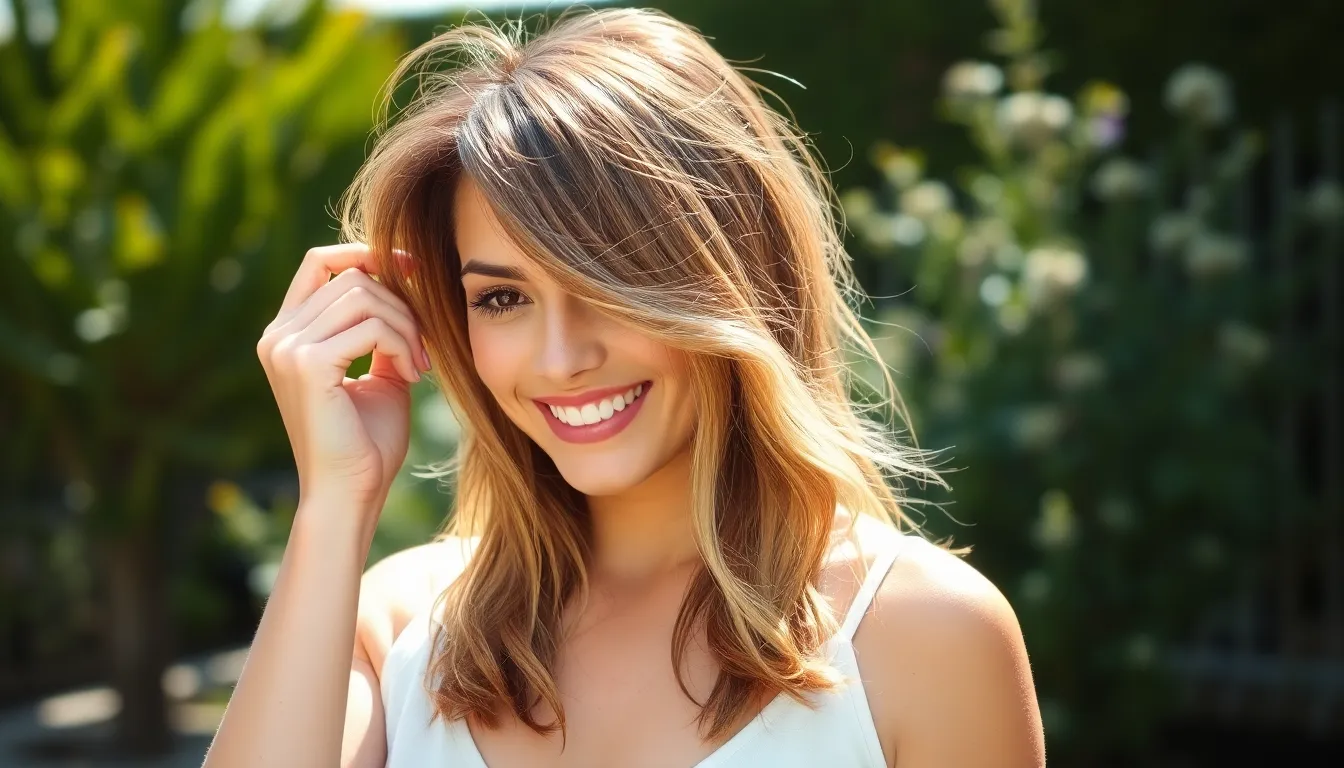
Versatility defines the butterfly haircut’s greatest strength, allowing you to transform your look effortlessly throughout the day. We’ll explore styling methods that enhance those signature face-framing layers for every situation.
Everyday Casual Styling Tips
Air drying creates the most effortless butterfly haircut styling approach. Apply a lightweight mousse from mid-length to ends while hair remains damp. Scrunch sections gently with your fingers to encourage natural texture and movement. The graduated layers will naturally fall into place as moisture evaporates.
Heat-free texturizing delivers volume without damage. Braid damp hair into loose plaits before sleeping, then finger-comb the waves in the morning. This technique preserves the haircut’s natural bounce while adding subtle texture to the shorter face-framing pieces.
Quick touch-ups require minimal effort throughout busy days. Mist a small amount of texturizing spray onto your palms and scrunch any flat areas. The butterfly cut’s layered structure responds instantly to gentle manipulation, restoring volume in seconds.
Low-maintenance styling suits rushed mornings perfectly. Twist small sections of the front layers while hair dries naturally, creating soft bends that highlight the cut’s wing-like movement. This approach works especially well for medium-length butterfly cuts.
Formal Event and Professional Looks
Sleek styling transforms butterfly layers into polished sophistication. Use a flat iron on low heat to smooth the hair straight, focusing extra attention on the face-framing pieces. Apply a shine serum to the mid-lengths and ends for a glossy, professional finish.
Half-up styles showcase the butterfly cut’s dimensional layers beautifully. Gather the top section loosely at the crown, leaving the shorter front pieces to frame your face naturally. This look works perfectly for business meetings or formal dinners.
Side-swept bangs elevate the butterfly haircut’s elegance instantly. Create a deep side part and sweep the front layers across your forehead using a round brush and blow dryer. The asymmetrical styling adds sophistication while maintaining the cut’s signature movement.
Tucked-behind-ear styling creates clean, professional lines. Smooth one side of your butterfly cut behind your ear using a small amount of styling gel. This asymmetrical approach highlights the layered structure while appearing workplace-appropriate.
Beach Waves and Textured Styling Options
Salt spray amplifies the butterfly haircut’s natural texture dramatically. Apply the product to damp hair, then scrunch sections randomly to create irregular wave patterns. The shorter layers will develop more defined curves than the longer pieces, creating beautiful dimension.
Diffusing enhances curl patterns in textured butterfly cuts. Set your blow dryer to low heat and speed, then cup sections of hair in the diffuser bowl. Move the tool in circular motions to encourage the layers’ natural movement while reducing frizz.
Braided waves offer controlled texture for special occasions. Create multiple small braids in damp hair, focusing on varying the tightness for different wave sizes. When you remove the braids, the butterfly layers will display a mix of loose and tighter waves.
Curling iron techniques can target exact sections for custom texture. Use a 1.5-inch barrel to curl only the face-framing layers, leaving the rest natural. This approach creates a romantic, effortless look that emphasizes the butterfly cut’s wing-like structure around your face.
Maintenance Requirements for Your Butterfly Haircut
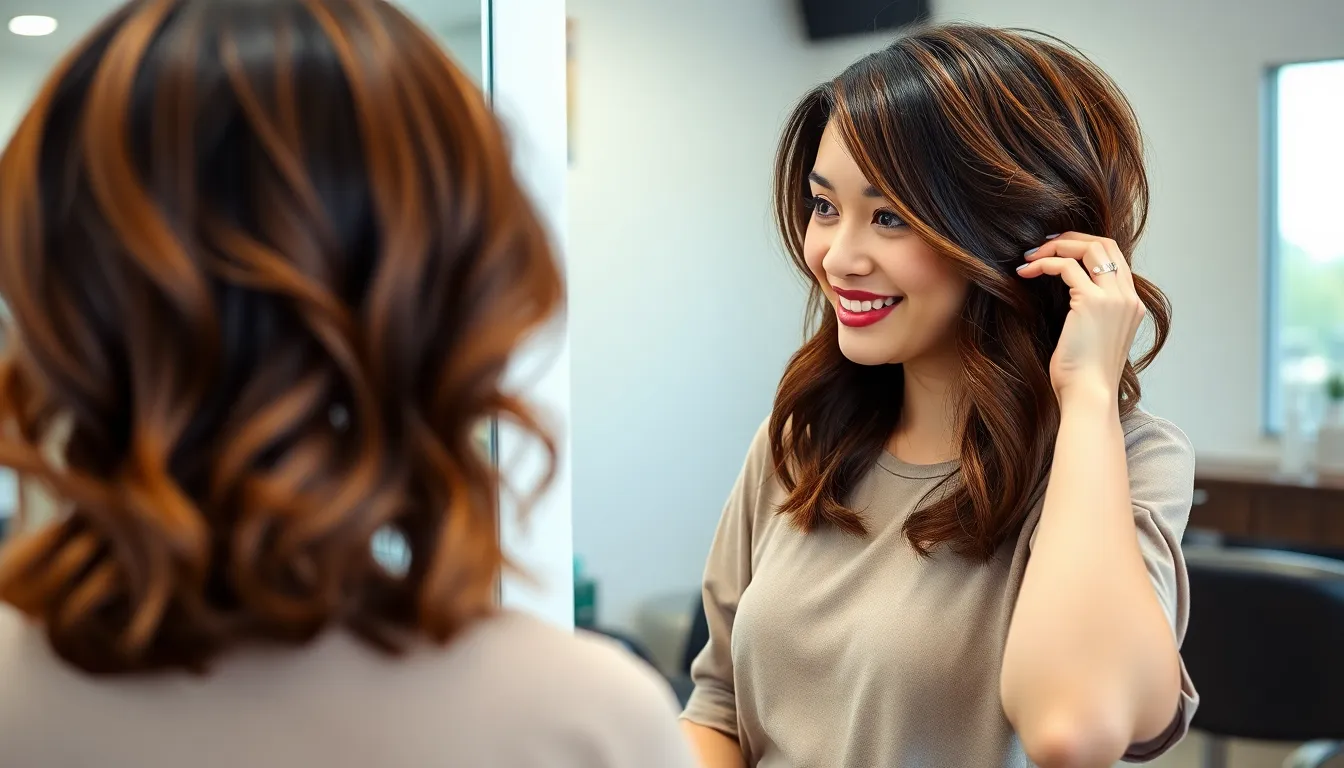
Proper maintenance ensures your butterfly haircut retains its signature shape and movement between salon visits. We’ll guide you through the essential care requirements to keep your layers looking fresh and voluminous.
Recommended Trim Frequency
Schedule trims every 6-8 weeks to maintain the butterfly haircut’s precise layering and prevent split ends from traveling up the hair shaft. Regular appointments preserve the face-framing layers that define this style’s signature look.
Book touch-ups every 4-6 weeks if you have fine or fast-growing hair that loses its shape quickly. Fine hair textures require more frequent maintenance to keep the graduated layers looking intentional rather than grown-out.
Consider seasonal adjustments during your regular trim schedule to accommodate changes in humidity and styling frequency. Summer months may require slightly more frequent trims due to increased heat styling and environmental exposure.
Maintain the perimeter length during each appointment to prevent the bottom layers from becoming too heavy and pulling down the overall shape. Your stylist should focus on refreshing the shortest layers around your face while preserving the overall length.
Essential Hair Care Products
Use volumizing shampoo and conditioner specifically formulated for layered cuts to enhance the natural movement and bounce in your butterfly haircut. We recommend sulfate-free formulas that won’t strip natural oils from your hair.
| Product Type | Key Benefits | Application Frequency |
|---|---|---|
| Volumizing Shampoo | Lifts roots, adds body | 2-3 times per week |
| Lightweight Conditioner | Moisturizes without weighing down | Every wash |
| Heat Protectant | Prevents damage from styling tools | Before each styling session |
| Texturizing Spray | Enhances layer definition | 2-3 times per week |
Apply leave-in treatments that target the mid-lengths and ends where your layers are most concentrated. Lightweight serums and oils help prevent frizz while maintaining the airy texture that makes butterfly cuts so appealing.
Incorporate weekly deep conditioning masks to keep your layered hair healthy and manageable. Focus the treatment on areas that receive the most heat styling or environmental stress.
Choose styling products that enhance natural texture without creating buildup that can weigh down your layers. Mousse, sea salt spray, and lightweight gels work best for maintaining volume and definition.
At-Home Styling Routine
Start with damp hair and apply a volumizing mousse from roots to mid-lengths to create lift and body in your butterfly layers. Work the product through with your fingers to ensure even distribution without disrupting natural curl patterns.
Blow-dry using a round brush to enhance the face-framing layers while creating movement throughout the cut. Focus on lifting the roots and directing the shorter layers away from your face to achieve the signature butterfly wing effect.
Use a diffuser attachment for curly or wavy hair to maintain natural texture while adding definition to your layers. Scrunch sections gently while drying to encourage curl formation and prevent frizz.
Finish with texturizing spray applied to the mid-lengths and ends to enhance layer separation and create piece-y definition. Scrunch the product into your hair with your hands for a natural, lived-in texture.
Refresh between washes using dry shampoo at the roots and a light misting of texturizing spray on the lengths. This routine extends your style while maintaining the volume and movement that characterize the butterfly haircut.
Celebrity Inspiration: Famous Butterfly Haircut Looks

The butterfly haircut has gained momentum through celebrity endorsements and social media showcases. We’ve seen this versatile style evolve through various interpretations across red carpets and digital platforms.
Billie Eilish’s Iconic Interpretation
Billie Eilish transformed the butterfly haircut into a statement piece with her signature voluminous styling approach. Her interpretation features dramatic face framing layers that create bold movement around her features. We’ve observed how she maintains the haircut’s natural texture while adding subtle waves that enhance the wing like effect.
The pop star’s styling technique emphasizes air dried texture combined with strategic scrunching methods. She often incorporates lightweight texturizing products to maintain the haircut’s bouncy appearance without weighing down the layers. Her approach demonstrates how the butterfly cut adapts to alternative aesthetics while preserving its core structural elements.
Eilish frequently styles her butterfly haircut with center parts that showcase the graduated layering system. We notice she emphasizes the shorter face framing pieces through gentle tousling techniques that create natural separation between layers.
Other A-List Celebrity Variations
Sabrina Carpenter showcases a softer butterfly haircut interpretation that emphasizes romantic movement and feminine appeal. Her version incorporates subtle highlights that accentuate the layered structure while maintaining a polished finish. We’ve seen her style the cut with loose curls that amplify the wing like silhouette.
Hailey Bieber adapts the butterfly haircut for sleek styling occasions through strategic blow drying techniques. Her approach focuses on smoothing the layers while maintaining volume at the crown area. She demonstrates how the cut transitions seamlessly from casual textures to refined red carpet looks.
Sydney Sweeney presents a voluminous butterfly haircut variation that emphasizes bounce and movement through her styling choices. We observe how she uses round brush techniques to create lifted roots while keeping the face framing layers soft and wispy. Her interpretation proves the haircut’s versatility across different hair densities.
Social Media Influencer Trends
TikTok creators have popularized DIY butterfly haircut tutorials that showcase accessible styling methods for everyday wear. We’ve tracked millions of views on butterfly haircut content across social platforms during the past year. Influencers demonstrate quick styling techniques using readily available products like sea salt spray and diffusers.
Instagram beauty influencers focus on product recommendations that enhance the butterfly haircut’s natural texture and volume. They showcase before and after transformations that highlight the dramatic difference proper layering creates. We notice trending hashtags like #butterflyhaircut and #layeredcut generating important engagement rates.
YouTube hair stylists provide detailed tutorials that break down professional cutting techniques for at home attempts. Their content emphasizes safety measures and realistic expectations for achieving butterfly haircut results without professional training. We see increased searches for butterfly haircut maintenance tips and styling product reviews across these platforms.
Common Mistakes to Avoid With Butterfly Haircuts
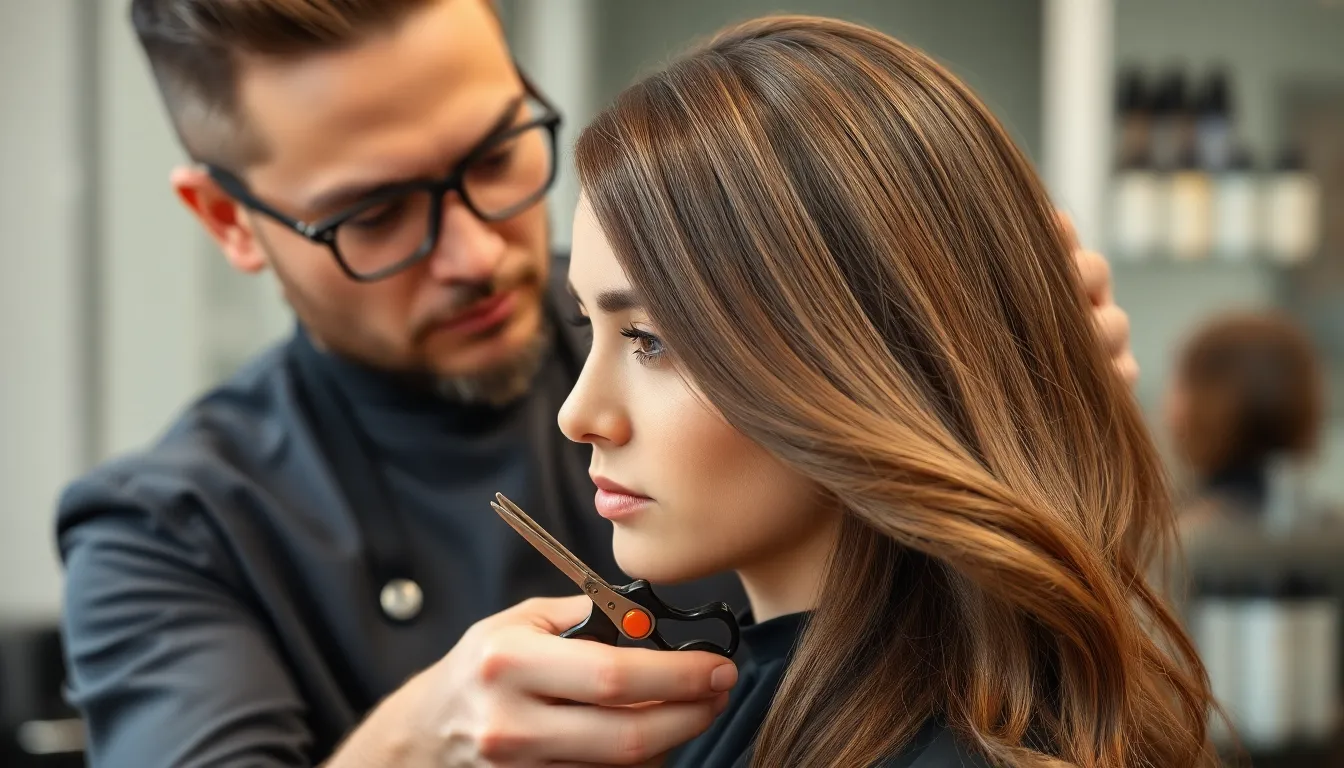
Butterfly haircuts require precise execution and thoughtful styling to achieve their signature feathered layers and face-framing volume. Avoiding these common pitfalls will help you maintain the haircut’s natural movement and prevent styling disasters.
Over-Layering Pitfalls
Excessive layering destroys the butterfly haircut’s natural weight distribution and creates choppy, unmanageable texture. Professional stylists recommend limiting layers to 3-4 distinct sections to maintain the cut’s flowing movement and prevent hair from appearing thin or stringy.
Point cutting mistakes occur when stylists remove too much hair in single sessions, leading to overly textured ends that won’t hold volume. We’ve observed clients with over-pointed cuts struggling to achieve the butterfly effect’s signature bounce and fullness.
Channel cutting errors happen when stylists cut too many interior layers without considering hair density. Fine hair becomes wispy and lacks body, while thick hair develops unwanted bulk in unexpected areas that disrupts the haircut’s natural silhouette.
Weight line removal eliminates the foundation that butterfly cuts need for proper shape retention. Maintaining strategic weight at mid-lengths ensures layers cascade naturally and prevents the mushroom effect that occurs when too much hair gets removed from interior sections.
Wrong Face Shape Matching
Round face modifications require avoiding layers that add width at cheek level, yet many stylists create horizontal cutting lines that emphasize facial roundness. Strategic vertical layering starting below the jawline elongates features while maintaining the butterfly cut’s characteristic volume.
Square face adaptations need softening around angular jawlines, but heavy blunt layers can accentuate harsh features instead of minimizing them. Wispy, graduated layers that begin at chin level create the gentle framing effect that complements strong bone structure.
Heart shaped face adjustments demand careful consideration of forehead width and narrow chin proportions. Adding too much volume at crown level overwhelms delicate features, while insufficient layering around the jawline fails to balance wider foreheads effectively.
Long face corrections become problematic when stylists create excessive vertical layers that elongate features further. Maintaining width through strategic layering at ear level and avoiding steep graduation prevents the butterfly cut from making faces appear disproportionately narrow.
Improper Styling Techniques
Heat damage occurs when styling tools exceed 300°F temperatures or remain in contact with hair too long during butterfly cut styling. Using lower heat settings with quality thermal protection preserves the cut’s texture and prevents layers from becoming brittle or losing their natural movement.
Product overload weighs down the butterfly cut’s signature lightness and prevents layers from bouncing naturally. We recommend using quarter-sized amounts of volumizing mousse and avoiding heavy oils or creams that flatten face-framing sections.
Brushing mistakes include using paddle brushes on wet hair or brushing layers downward instead of lifting them for volume. Round brushes with mixed bristles work best for butterfly cuts, allowing you to direct layers upward and outward for proper shape maintenance.
Sectioning errors during styling prevent achieving symmetrical volume and can create lopsided appearances. Dividing hair into horizontal sections from ear to ear ensures even heat distribution and consistent lift throughout all layers of the butterfly cut.
Professional vs DIY: Should You Cut It Yourself
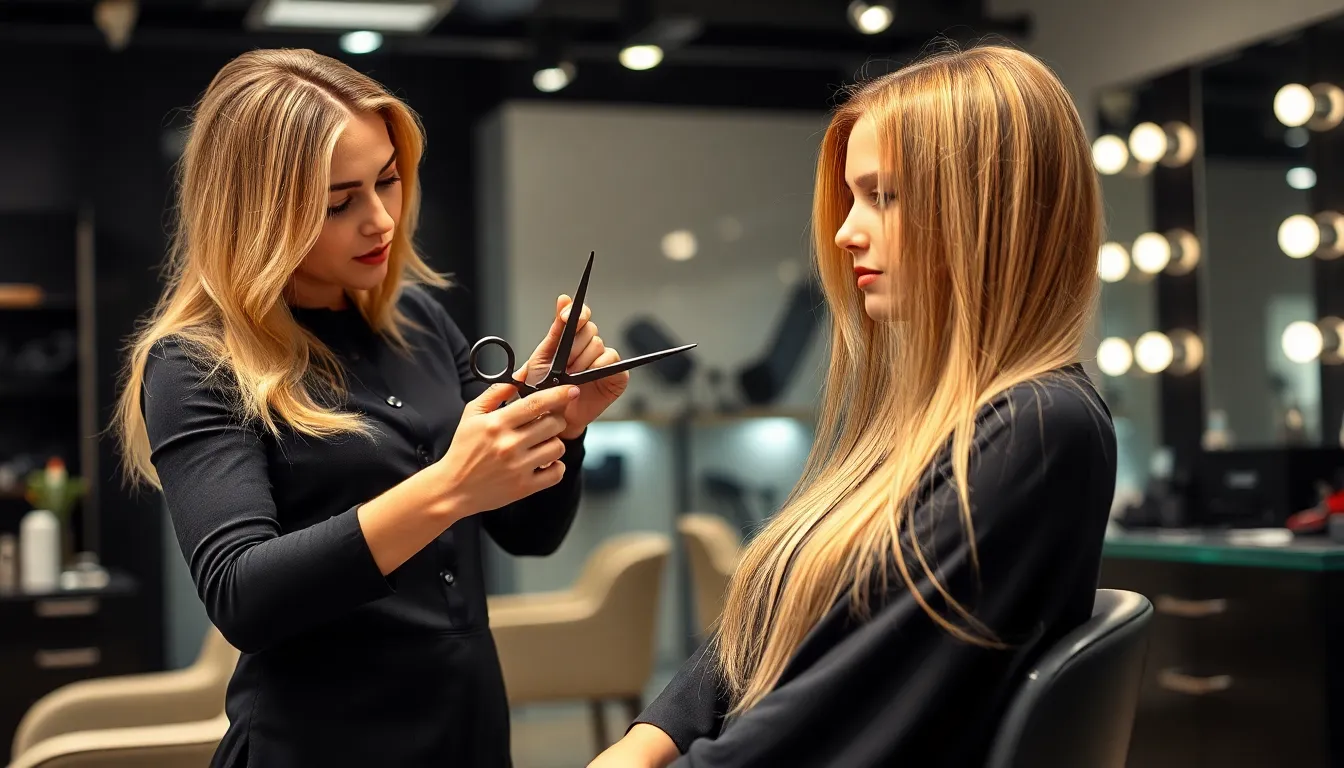
Choosing between professional salon services and attempting the butterfly haircut at home significantly impacts your final results and overall satisfaction.
Benefits of Professional Salon Services
Professional stylists bring years of training and specialized expertise to execute the butterfly haircut’s complex layering techniques. We’ve observed that certified hairdressers understand how to assess your face shape, hair texture, and growth patterns to customize the cut perfectly for your features. Advanced cutting methods like point cutting and slide cutting require precise hand positioning and angle control that professionals master through extensive practice.
Skilled colorists can also integrate highlights or lowlights to enhance the butterfly haircut’s dimensional layers. Professional salons use high-grade tools including Japanese steel shears, professional thinning shears, and ergonomic razors that create cleaner cuts than consumer-grade equipment. Quality assurance comes standard as experienced stylists can correct mistakes immediately and adjust the cut during the service.
Expert consultation ensures you receive honest feedback about whether the butterfly haircut suits your lifestyle and maintenance preferences. Professional stylists often provide detailed styling tutorials and recommend exact products customized to your hair type. Insurance coverage protects clients if anything goes wrong during the cutting process.
Risks of At-Home Cutting
Attempting the butterfly haircut without professional training can result in uneven layers that destroy the style’s signature flow and movement. We’ve documented cases where DIY attempts created choppy sections, asymmetrical face-framing pieces, and disconnected weight lines that require extensive correction. Improper sectioning techniques often lead to gaps in coverage or overlapping cuts that compromise the overall shape.
Lack of proper mirrors and lighting makes it nearly impossible to see all angles while cutting your own hair. Home cutting tools typically lack the sharpness and precision needed for clean layer transitions. Inexperience with tension control can cause sections to be cut too short or at incorrect angles.
Emotional stress during self-cutting often leads to impulsive decisions and overcorrection attempts. Chemical processing errors can occur when combining at-home coloring with cutting, potentially causing breakage or unwanted color results. Fixing DIY mistakes usually costs more than the original professional service would have.
Cost Comparison Considerations
Professional butterfly haircuts typically range from $75 to $200 depending on your location, salon reputation, and stylist experience level. Premium salons in major metropolitan areas charge $150 to $300 for master stylists who specialize in advanced layering techniques. We recommend budgeting an additional 20% for tipping excellent service.
DIY cutting appears cost-effective initially with professional shears costing $40 to $100 and thinning shears adding another $30 to $60. But, correction appointments often cost $100 to $250 when mistakes require professional intervention. Emergency salon visits can exceed the original professional cutting fee by 50% or more.
Long-term value favors professional services since properly executed cuts grow out more gracefully and require fewer frequent trims. Professional stylists create cuts that maintain their shape for 8 to 12 weeks compared to DIY attempts that may need correction within 2 to 4 weeks. Investment in quality professional services eventually saves money through reduced maintenance needs and longer intervals between appointments.
Butterfly Haircut Variations for Different Hair Types
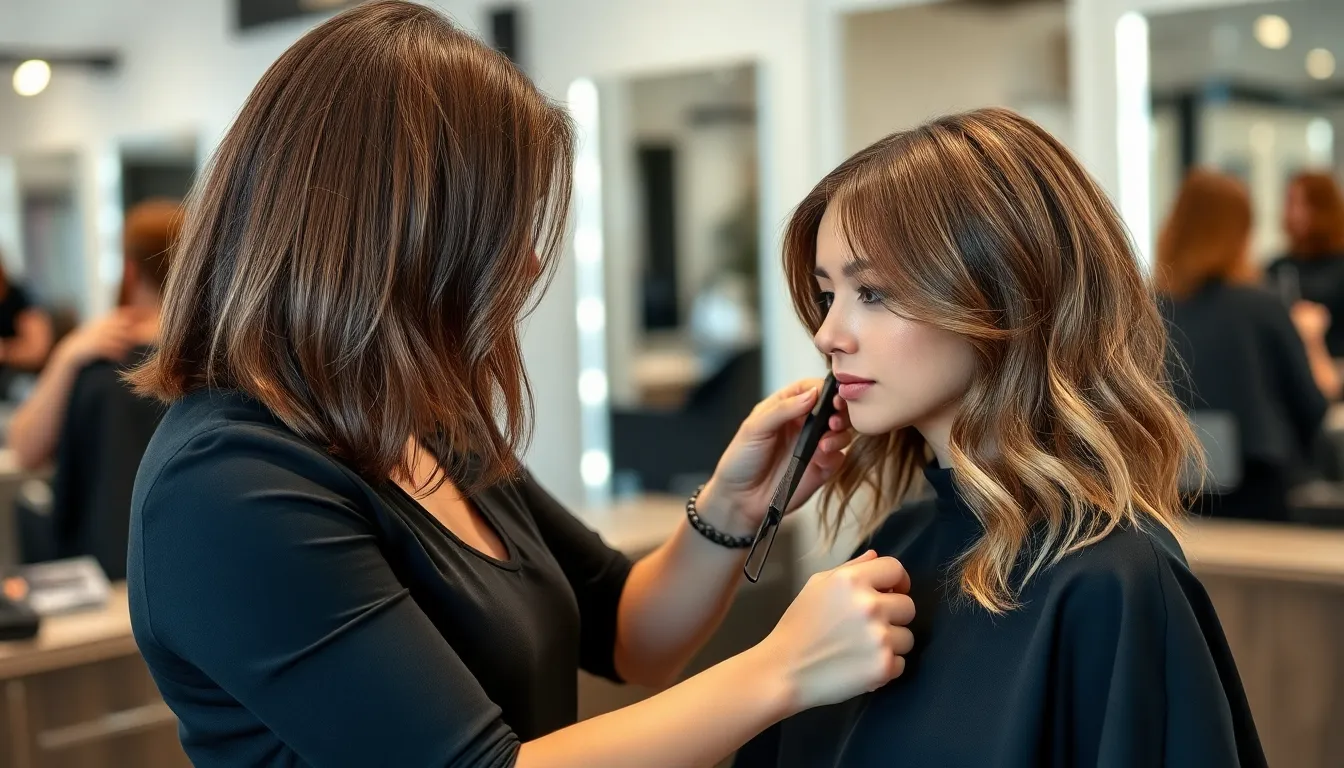
Every hair type can achieve the butterfly haircut with proper adaptation techniques. We’ll explore exact modifications that maximize your natural texture while maintaining the signature layered movement.
Fine Hair Adaptations
Strategic layering creates the illusion of fullness in fine hair without removing too much weight. We recommend keeping layers slightly longer than standard butterfly cuts to maintain density throughout the style. Point cutting at minimal angles preserves volume while adding subtle movement around the face.
Graduated layers work best when positioned higher on the head to create lift at the roots. Professional stylists typically start face framing layers at cheekbone level rather than jaw level to avoid thinning out delicate strands. This positioning maintains the butterfly effect while improving natural body.
Weight distribution becomes crucial for fine hair success with this cut. We suggest leaving more weight in the mid lengths and concentrating shorter layers only around the perimeter. Thinning shears should be used sparingly to prevent creating sparse looking ends.
Texturizing techniques require gentle approaches such as light channel cutting instead of aggressive razor work. Slide cutting helps create movement without compromising hair density. These methods preserve the maximum amount of hair while achieving the desired shape.
Thick Hair Modifications
Heavy hair benefits from strategic weight removal through deeper layering techniques that maintain the butterfly silhouette. We recommend starting face framing layers higher up to manage bulk while creating dramatic movement. Point cutting at steeper angles helps thin out thick sections without losing the overall shape.
Channel cutting becomes essential for managing thick hair texture in butterfly cuts. This technique removes internal weight while preserving length and creating natural movement. Professional stylists often use multiple channeling sessions to gradually thin dense areas.
Razor cutting works exceptionally well on thick hair types when creating butterfly layers. The razor naturally thins out heavy sections while adding texture and movement. We suggest combining razor techniques with traditional shear work for optimal results.
Layering depths require adjustment in thick hair to prevent the style from looking too heavy or triangular. Starting layers closer to the crown helps distribute weight evenly. Internal layering techniques remove bulk without affecting the outer silhouette.
Curly and Wavy Hair Versions
Curl pattern considerations determine the best approach for butterfly cuts on textured hair. Type 2 waves respond well to traditional layering methods with slight modifications for curl enhancement. Type 3 curls need specialized cutting techniques that work with natural curl formation.
Dry cutting proves most effective for curly butterfly haircuts since it allows stylists to see exactly how curls will fall naturally. We recommend cutting curls in their stretched state to ensure even layer distribution. This method prevents shrinkage surprises and maintains consistent length relationships.
Spiral cutting techniques create optimal results for tighter curl patterns in butterfly styles. Each curl gets cut individually at different lengths to enhance natural movement. This approach ensures that face framing layers complement the curl pattern rather than fighting against it.
Moisture retention becomes critical for maintaining curly butterfly cuts since layers can increase dryness risk. We suggest incorporating protective cutting angles that seal hair cuticles. Leave in treatments and curl exact products help maintain the integrity of layered curly sections.
Diffusing methods enhance the butterfly effect in curly hair by encouraging volume at the roots while defining individual curl clumps. Scrunching techniques during styling help activate the layered movement. Natural air drying often produces the most authentic curly butterfly results.
Conclusion
The butterfly haircut’s meteoric rise proves that when vintage meets modern technique the results can be absolutely groundbreaking. We’ve explored every angle from celebrity interpretations to professional cutting methods and it’s clear this isn’t just another fleeting trend.
Whether you’re drawn to its face-framing versatility or the effortless volume it creates the butterfly cut offers something for everyone. The key lies in understanding your unique features and working with a skilled stylist who can adapt the technique to your exact needs.
With proper maintenance and the right styling approach this cut will continue to evolve with you. The butterfly haircut represents more than just a hairstyle – it’s a statement of confidence that celebrates both classic elegance and contemporary edge.
Frequently Asked Questions
What is a butterfly haircut?
A butterfly haircut is a modern layered hairstyle that features dramatic face-framing layers resembling butterfly wings when styled. It combines vintage glamour with contemporary styling, offering graduated layers for natural volume and movement. The cut gets its name from the way shorter layers around the face create a wing-like effect when styled with volume and texture.
Which face shapes work best with the butterfly haircut?
The butterfly haircut is versatile and works well with most face shapes. Oval faces can showcase the cut’s symmetry and styling options. Round faces benefit from the elongating effect of strategic layering. Square and angular faces are softened by the wispy layers, creating a more balanced appearance.
How often should I trim my butterfly haircut?
You should trim your butterfly haircut every 6-8 weeks to maintain its shape and prevent split ends. Those with fine or fast-growing hair may need touch-ups more frequently. Regular trims are essential for preserving the layered structure and ensuring the face-framing layers continue to enhance your features effectively.
Can I cut a butterfly haircut at home?
While DIY tutorials exist on social media platforms, the butterfly haircut requires precise layering techniques best executed by professional stylists. At-home attempts risk uneven layers, improper weight distribution, and disrupted volume. Professional stylists have the expertise, tools, and ability to customize the cut based on your individual features.
What hair types can achieve the butterfly haircut?
Every hair type can achieve the butterfly haircut with proper techniques. Fine hair benefits from strategic layering for added fullness. Thick hair requires deeper layering to manage bulk while maintaining the silhouette. Curly and wavy hair work well with dry cutting techniques that enhance natural curl patterns and volume.
How do I style my butterfly haircut for different occasions?
For casual looks, air dry with mousse and use heat-free texturizing methods. For formal events, try sleek styling, half-up styles, or side-swept bangs. Beach waves can be created using salt spray and diffusing techniques. The cut’s versatility allows for quick touch-ups and various styling options to suit any occasion.
What products do I need to maintain a butterfly haircut?
Essential products include volumizing shampoo, lightweight conditioner, heat protectant, and texturizing spray. These help maintain volume, definition, and protect against heat damage. Apply products to damp hair, blow-dry with a round brush for volume, and refresh styles between washes with dry shampoo or texturizing spray.
What are common mistakes to avoid with a butterfly haircut?
Avoid over-layering, which can disrupt natural movement and volume. Don’t attempt point cutting without proper technique, and ensure weight lines are removed correctly. Styling mistakes include using too much product, excessive heat, and creating uneven volume. Proper execution and thoughtful styling are crucial for maintaining the cut’s signature look.




